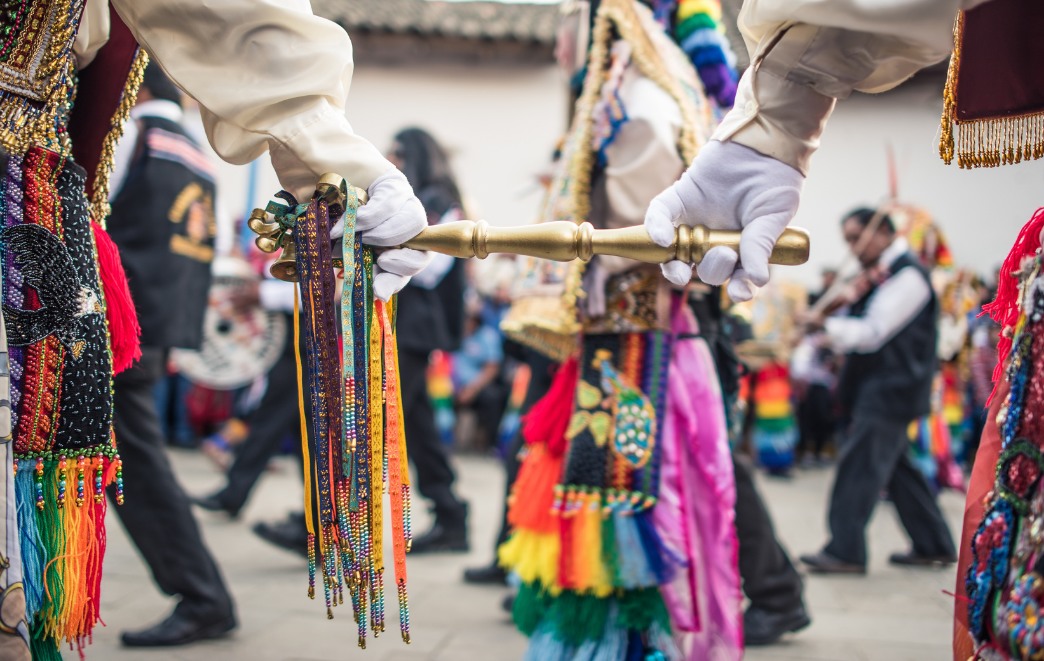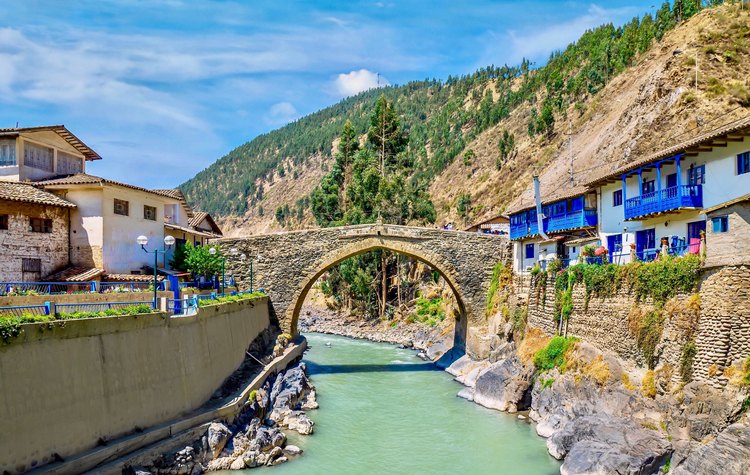
“Paucartambo, Paucartambo, ahí te dejo mi recuerdo, kutimunaykama.” (Paucartambo, Paucartambo, I leave my memories with you, until I long to return) – From the song “Paucartambo”
In July, this refrain rings through the Peruvian Andes to pay homage to one of the most exciting Peruvian festivals year-round: Virgen del Carmen in Paucartambo. Every year, from July 15th-19th, the Virgen del Carmen Festival in the Cusco province of Paucartambo becomes a major focus for thousands of locals and tourists alike.
This year, the festivities are on hold yet again due to the ongoing struggle with COVID-19 in Peru; however, the spirit of Paucartambo is as alive as ever. In this article, we recount some of the most exciting moments of the Paucartambo festival and relate a bit of its history filled with ornately orchestrated dances, live music, fireworks, and plenty of chela (beer).
Virgen del Carmen History

While the details of the legend escape many festival-goers, the heart of the story is quite consistent. So, how and why did Carmen became la patrona (patron saint) of Paucartambo? As the legend goes, it all started in the 13th century, when a local wealthy woman was heading to Paucartambo to trade a silver dish and came across a beautiful, bodiless head.
More bewildered than frightened, the woman decided to place this head on her dish. Suddenly, the head began to speak to the young woman and said her name was Carmen, and that she was a virgin. The virginal head, so the legend continues, calmly conversed with this woman and told her not to fear her, but quite the opposite: to trust her.
Soon, the people of Paucartambo began to ask Carmen for wishes related to the health and happiness of the community. Then, the residents of Paucartambo witnessed rays of light emanating from her head, and shortly after that, she performed many miracles within the community.
As a result, every year, in the middle of July, the festival lives on to extend Carmen’s bounty of miracles to Paucartambo and now to many other surrounding Peruvian provinces, including Cusco City.
What is the festival in Paucartambo like?

La Virgen del Carmen is not only one of the largest festivals in Peru, but it is also hands-down one of the happiest and most colorful! Annually, people from many distinct corners of Peru (but mainly from the department of Cusco) make their way to Paucartambo. Spiritual, catholic, and cultural pilgrims cram into a town with one central plaza and many narrowly winding streets.
Sleep isn’t a priority for most festival-goers, and often their sleeping arrangements are rudimentary; this said, more complete accommodations will definitely be arranged ahead of time if you book the experience through Kuoda. But don’t be surprised to find most sleeping in tents or in mattresses on balconies that overlook the festivities, or really anywhere with an available square of space.
When you enter the festival, you will find nonstop revelry complete with incessant fireworks and plenty of free-flowing alcohol. The masked characters swirl around you in a perpetual haze of beer, chicha, and pure joy in this five-day celebration of La Gran Mamacha Carmen.
About six o’clock in the evening on the 17th marks the middle of the festival, and there is a definite pause amongst the pilgrims and dancers alike. The wealthier members of Paucartambo are each assigned a dance and donate all of the money necessary towards their party space (which doubles as a lodging space), food, and alcohol.
This phenomenon is called a cargo. And so, all of the dancers rest, eat and drink in their respective cargos at this point of the festival. It is typically acceptable and even expected to “crash,” said cargos. So, don’t be surprised if you are pulled onto the dance floor to try your hand at the twirling huayno steps alongside the dancers.
Principal characters and dances
Much like the Festival of Qoyllur Rit’i (Snow Star in Quechua), which takes place in late May or early June depending on the year, the beautifully adorned comparsas (dance troupes) of Paucartambo and their accompanying band of musicians hardly stop moving. The majority of these sixteen dances in total are caricatures from different periods from Peruvian history.
Although we would love to go into the history, costumes, and unique story behind each dance, we do want to leave some to the imagination for you to discover on your own someday. For now, we would like to highlight six dances in particular: Qhapac Qolla, Saqra, Chunchachas, Qhapaq Negro, Qhapaq Chunchu, and Maqta.
Qhapaq Qolla
Accompanied by llamas and adorned with multi-colored ribbons, the Qhapaq Qolla dancers represent the moment of encuentro (encounter) with the head of La Gran Mamacha Carmen. They symbolize those with the most faith in Carmen, the most devoted.
The Qhapaq Qollas are not alone in telling a rich and intricate story of the history and culture of Peru. Something worth noting is every dance in the festival is unique in movement and costume, and information about the origin and characteristics of each one is provided in the form of large posters on a wall in the central plaza of Paucartambo.
Saqra

Saqra means “devil” or “demon” in Quechua. This particular dance comes from the Republic in Peru, which extended from their year of independence in 1821 to roughly 1930. During this period of Peruvian history, there were quite a few land disputes between Peru and the neighboring countries of Ecuador, Chile, and Bolivia.
The dance itself is a fantastical and fun interpretation of the demons trapped in purgatory. There are three types of devils to contend with, 1) el diablo corporal, 2) la china saqra (the girl devil, as china, means “female” in Quechua), and 4) los soldados. All of the devils dress head to toe in colorful silk garb, resembling a joker’s clothing, multi-colored manes, and horned plaster masks.
Chunchachas

The Chunchachas are the only comparsa comprised entirely of women, who dance in twelve pairs. The origin of this dance reaches back to the Qosñipata Valley, at the entrance of the Manu National Park in the Southern Peruvian Amazon jungle. The Chunchachas represent the native communities of this area who would travel each year to Paucartambo to honor Carmen.
The dance was MIA in the festival for many years until the 1990s, when it made a comeback and is now one of the most coveted dances of Paucartambo. The women wear a type of Amazon crown, an ornate chest plate representing the Virgin Carmen, and two woven chuspas (purses) carrying wayruro seeds for good luck.
Qhapaq Negro
The Qhapaq Negro dancers pay homage to the former Afro-Peruvian slaves, who were brought over from the coast and Bolivia to work in the gold and silver mines in Paucartambo. As legend has it, these slaves already held la Virgen del Carmen in high regard before ever stepping foot in Paucartambo, which is why they are considered some of the most devoted dancers within the festival.
Qhapaq Negro dancers wear white billowy shirts, ornately embroidered colorful vests, pitch-black plaster masks, and a type of pillbox hat, also embroidered. They carry noisemakers and sing the most hauntingly beautiful melodies in both Quechua and Spanish, referencing their suffering as slaves and devotion to Carmen.
Qhapaq Chunchu

You may have noticed this is the third dance with the Quechua word Qhapaq, meaning “royal.” The Qhapaq Chunchu, the Qhapaq Qolla, and Qhapaq Negro are considered the most emblematic protagonists of the entire Paucartambo festival. The Qhapac Chunchu dancers represent native jungle communities, much like the Chunchachas.
This dance is unique because there are various roles cast amongst the dancers. You will be able to spot the “rey chunchu,” the king, and leader of the dance by his gold crown, in contrast to the feather crowns of the other Chunchus. There is also a kusillu (monkey) and a child known as the “reicito chunchu,” meaning the little king.
Maqta
Put simply, Maqta dancers are the loveable buffoon of the festival as an exaggerated caricature of the campesinos, or farm workers, of Peru. The dance originated in the department of Ayacucho, east of the department of Cusco and Peru’s folkloric heartland.
Maqta dancers weave through the festival in their own goofy dance and then wander off to play harmless tricks on unsuspecting onlookers. Sometimes they even launch into highly entertaining and dramatic monologues. Their costumes, bursting with color, consist of a chu’llo (earflap hat), a plaster mask sporting a joyful expression, a multi-colored vest, and a wool whip.
For these five days in Paucartambo, no one seems preoccupied with their worries, day jobs, or their “stuff.” Instead, sheer alegría (happiness) pulses through the crowds. All in all, if you choose to make the journey to Paucartambo, as part of your cusctom Peru tour for this extraordinary celebration in mid-July, you are sure to leave your memories behind until you long to return, as the song goes…
How To Experience Peruvian Artwork and Craftsmanship on Your Next Tour To Peru
Peru’s rich heritage is brought to life through its vibrant handicrafts. From colorful textiles to intricate...
Read PostKuoda’s Guide to the 2024 Inti Raymi Festival
The 2024 Inti Raymi festival will stand as a tribute to the grandeur of the Inca Empire, steeped in centuries ...
Read PostFascinating Facts You Should Know About the Incas
Curious to know some facts about the Incas? Explore Inca Heritage with Kuoda Travel. Well, for starters, depen...
Read Post

 Call
Call 























